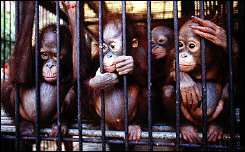Humans related to orangutans, not chimps

New evidence underscores the theory of human origin that suggests humans most likely share a common ancestor with orangutans, according to research from the University of Pittsburgh and the Buffalo Museum of Science. Reporting in the June 18 edition of the Journal of Biogeography, the researchers reject as "problematic" the popular suggestion, based on DNA analysis, that humans are most closely related to chimpanzees, which they maintain is not supported by fossil evidence.
Jeffrey H. Schwartz, professor of anthropology in Pitt's School of Arts and Sciences and president of the World Academy of Art and Science, and John Grehan, director of science at the Buffalo Museum, conducted a detailed analysis of the physical features of living and fossil apes that suggested humans, orangutans, and early apes belong to a group separate from chimpanzees and gorillas. They then constructed a scenario for how the human-orangutan common ancestor migrated between Southeast Asia—where modern orangutans are from—and other parts of the world and evolved into now-extinct apes and early humans. The study provides further evidence of the human-orangutan connection that Schwartz first proposed in his book The Red Ape: Orangutans and Human Origins, Revised and Updated (Westview Press, 2005).
Schwartz and Grehan scrutinized the hundreds of physical characteristics often cited as evidence of evolutionary relationships among humans and other great apes—chimps, gorillas, and orangutans—and selected 63 that could be verified as unique within this group (i.e., they do not appear in other primates). Of these features, the analysis found that humans shared 28 unique physical characteristics with orangutans, compared to only two features with chimpanzees, seven with gorillas, and seven with all three apes (chimpanzees, gorillas, and orangutans). Gorillas and chimpanzees shared 11 unique characteristics.
Schwartz and Grehan then examined 56 features uniquely shared among modern humans, fossil hominids—ancestral humans such as Australopithecus—and fossil apes. They found that orangutans shared eight features with early humans and Australopithecus and seven with Australopithecus alone. The occurrence of orangutan features in Australopithecus contradicts the expectation generated by DNA analysis that ancestral humans should have chimpanzee similarities, Schwartz and Grehan write. Chimpanzees and gorillas were found to share only those features found in all great apes.
Schwartz and Grehan pooled humans, orangutans, and the fossil apes into a new group called "dental hominoids," named for their similarly thick-enameled teeth. They labeled chimpanzees and gorillas as African apes and wrote in Biogeography that although they are a sister group of dental hominoids, "the African apes are not only less closely related to humans than are orangutans, but also less closely related to humans than are many" fossil apes.
The researchers acknowledge, however, that early human and ape fossils are largely found in Africa, whereas modern orangutans are found in Southeast Asia. To account for the separation, they propose that the last common human-orangutan ancestor migrated between Africa, Europe, and Asia at some point that ended at least 12 million to 13 million years ago. Plant fossils suggest that forests once extended from southern Europe, through Central Asia, and into China prior to the formation of the Himalayas, Schwartz and Grehan write, proposing that the ancestral dental hominoid lived and roamed throughout this vast area; as the Earth's surface and local ecosystems changed, descendant dental hominoids became geographically isolated from one another.
Schwartz and Grehan compare this theory of ancestral distribution with one designed to accommodate a presumed human-chimpanzee relationship. They write that in the absence of African ape fossils more than 500,000 years old, a series of "complicated and convoluted" scenarios were invented to suggest that African apes had descended from earlier apes that migrated from Africa to Europe. According to these scenarios, European apes then diverged into apes that moved on to Asia and into apes that returned to Africa to later become humans and modern apes. Schwartz and Grehan challenge these theories as incompatible with the morphological and biogeographic evidence.
Paleoanthropologist Peter Andrews, a past head of Human Origins at the London Natural History Museum and coauthor of The Complete World of Human Evolution (Thames & Hudson, 2005), said that Schwartz and Grehan provide good evidence to support their theory. Andrews had no part in the research, but is familiar with it.
"They have good morphological evidence in support of their interpretation, so that it must be taken seriously, and if it reopens the debate between molecular biologists and morphologists, so much the better," Andrews said. "They are going against accepted interpretations of human and ape relationships, and there's no doubt their conclusions will be challenged. But I hope it will be done in a constructive way, for science progresses by asking questions and testing results."
Schwartz and Grehan contend in the Journal of Biogeography that the clear physical similarities between humans and orangutans have long been overshadowed by molecular analyses that link humans to chimpanzees, but that those molecular comparisons are often flawed: There is no theory holding that molecular similarity necessarily implies an evolutionary relationship; molecular studies often exclude orangutans and focus on a limited selection of primates without an adequate "outgroup" for comparison; and molecular data that contradict the idea that genetic similarity denotes relation are often dismissed.
"They criticize molecular data where criticism is due," said Malte Ebach, a researcher at Arizona State University's International Institute for Species Exploration who also was not involved in the project but is familiar with it.
"Palaeoanthropology is based solely on morphology, and there is no scientific justification to favor DNA over morphological data. Yet the human-chimp relationship, generated by molecular data, has been accepted without any scrutiny. Grehan and Schwartz are not just suggesting an orangutan-human relationship—they're reaffirming an established scientific practice of questioning data."
Source: University of Pittsburgh

















